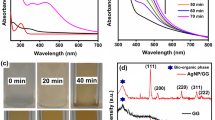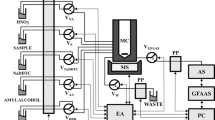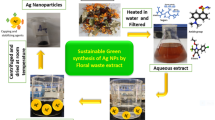Abstract
A new procedure for the determination of silver (Ag) in Ag-loaded cellulosic materials is proposed that is based on a spectroscopic method. Two calibration models were established based on ultraviolet–visible (UV–vis) spectroscopy (Model 1) and ratio spectrum-derivative spectrophotometry (Model 2). The correlation coefficient of Model 1 is 0.9852 when the concentration of silver ions (Ag+) in AgCl suspension system is < 1.0 mmol/l. By contrast, Model 2 exhibits an extended detection range, from 0 to 1.2 mmol/l, and its correlation coefficient was as large as 0.9941. The standard deviation of 0.8080 for Model 2 is substantially lower than that of Model 1 (1.0744), which explains why better reproducibility was achieved by the former. Validation experiments show the average relative errors for two models, 5.15% (Model 1) and 2.35% (Model 2), respectively, which indicates that predictability of Model 2 is better than that of Model 1. Compared with traditional methods, the proposed test procedures were simpler, human errors were reduced, and testing time was shortened. The new method has high precision and accuracy and is satisfactorily applied for the determination of silver in Ag-loaded cellulosic materials.




Similar content being viewed by others
References
Ahamed M, AlSalhi MS, Siddiqui MKJ (2010) Silver nanoparticle applications and human health. Clin Chim Acta 411(23–24):1841–1848
Alexander JW (2009) History of the medical use of silver. Surg Infect 10:289–292
Amini E, Azadfallah M, Layeghi M, Talaei-Hassanloui R (2016) Silver-nanoparticle-impregnated cellulose nanofiber coating for packaging paper. Cellulose 23(1):1–14
Asghari S, Logsetty S, Liu S (2016) Imparting commercial antimicrobial dressings with low-adherence to burn wounds. Burns 42(4):877–883
Atiyeh BS, Costagliola M, Hayek SN, Dibo SA (2007) Effect of silver on burn wound infection control and healing: review of the literature. Burns 33(2):139–148
Beer C, Foldbjerg R, Hayashi Y, Sutherland DS, Autrup H (2012) Toxicity of silver nanoparticles-nanoparticle or silver ion? Toxicol Lett 208(3):286–292
Cao Y, Shi LH, Yu YH, Wang CF, Wang HJ (2014) Conjugated linolenic acid polymer dressings impregnated with silver nano-crystals: fabrication and dual inhibition functions assessment on tumor cells and microorganisms. Chem Eng J 245:150–157
Cutting K, White R, Edmonds M (2007) The safety and efficacy of dressings with silver-addressing clinical concerns. Int Wound J 4(2):177–184
Feng J, Shi QS, Li WR, Shu XL, Chen AM, Xie XB, Huang XM (2014) Antimicrobial activity of silver nanoparticles in situ growth on TEMPO-mediated oxidized bacterial cellulose. Cellulose 21(6):4557–4567
Gustaite S, Kazlauske J, Bobokalonov J, Perni S, Dutschk V, Liesiene J, Prokopovich P (2015) Characterization of cellulose based sponges for wound dressings. Colloids and surfaces A: physicochem. Eng Asp 480:336–342
Haider A, Kang IK (2015) Preparation of silver nanoparticles and their industrial and biomedical applications: a comprehensive review. Adv Mater Sci Eng 3:1–16
Hongve D, Åkesson G (1998) Comparison of nephelometric turbidity measurements using wavelengths 400–600 and 860 nm. Water Res 32(10):3143–3145
Kittler S, Greulich C, Gebauer JS, Diendorf J, Treuel L, Ruiz L (2009) The influence of proteins on the dispersability and cell-biological activity of silver nanoparticles. J Mater Chem 20(3):512–518
Kumar-Krishnan S, Prokhorov E, Hernández-Iturriaga M, Mota-Morales JD, Vázquez-Lepe M, Kovalenko Y (2015) Chitosan/silver nanocomposites: synergistic antibacterial action of silver nanoparticles and silver ions. Eur Polym J 67:242–251
Larsen ML, Clark AS (2014) On the link between particle size and deviations from the Beer–Lambert–Bouguer law for direct transmission. J Quant Spectrosc Radiat 133:646–651
Li R, He M, Li T, Zhang L (2015a) Preparation and properties of cellulose/silver nanocomposite fibers. Carbohyd Polym 115(115):269–275
Li Z, Wang L, Chen S, Feng C, Chen SY, Yin N, Yang JX, Wang HP, Xu YM (2015b) Facilely green synthesis of silver nanoparticles into bacterial cellulose. Cellulose 22(1):373–383
Mirjalili M, Yaghmaei N, Mirjalili M (2013) Antibacterial properties of nano silver finish cellulose fabric. J Nanostructure Chem 3:43–47
Nzekwe IT, Agubata CO, Umeyor CE, Okoye IE, Ogwueleka CB (2016) Synthesis of silver nanoparticles by sodium borohydride reduction method: optimization of conditions for high anti-staphylococcal activity. British J Pharm Res 14(5):1–9
Sun YG, Xia YN (2003) Shape-controlled synthesis of gold and silver nanoparticles. Science 298(5601):2176–2179
Tang J, Chen Q, Xu LG, Zhang S, Feng LZ, Cheng L, Xu H, Liu Z, Peng R (2013) Graphene oxide–silver nanocomposite as a highly effective antibacterial agent with species-specific mechanisms. ACS Appl Mater Inter 5(9):3867–3874
Torrent L, Iglesias M, Hidalgo M, Marguí E (2018) Determination of silver nanoparticles in complex aqueous matrices by total reflection X-ray fluorescence spectrometry combined with cloud point extraction. J Anal Atom Spectrom 33:383–394
Tran PA, Hocking DM, O’Connor AJ (2015) In situ formation of antimicrobial silver nanoparticles and the impregnation of hydrophobic polycaprolactone matrix for antimicrobial medical device applications. Mat Sci Eng C 47:63–69
Wu J, Zheng Y, Wen X, Lin Q, Chen X, Wu Z (2014) Silver nanoparticle/bacterial cellulose gel membranes for antibacterial wound dressing: investigation in vitro and in vivo. Biomed Mater 9(3):1–12
Zadeh HA, Javan Z (2015) Silica-coated Mn3O4 nanoparticles coated with an ionic liquid for use in solid phase extraction of silver(I) ions prior to their determination by AAS. Microchim Acta 182:1447–1456
Zhang P, Shao CL, Zhang ZY, Zhang MY, Mu JB, Guo ZC, Liu YC (2011) In situ assembly of well-dispersed Ag nanoparticles (AgNPs) on electrospun carbon nanofibers (CNFs) for catalytic reduction of 4-nitrophenol. Nanoscale 3:3357–3363
Acknowledgments
The present work was financially supported by the National Natural Science Foundation of China (Grant Nos. 31600472, 31500489, 31570566) and the Natural Science Foundation of Shandong Province (ZR2017LEM009). Associate Professor Lucian Lucia is thanked for linguistic assistance and improvement of the manuscript.
Author information
Authors and Affiliations
Corresponding authors
Ethics declarations
Conflict of interest
The authors declare that they have no conflict of interest.
Rights and permissions
About this article
Cite this article
Fang, L., Chen, H., Kong, F. et al. Rapid spectroscopic determination of silver in Ag-loaded cellulosic materials. Cellulose 26, 1535–1543 (2019). https://doi.org/10.1007/s10570-018-2192-6
Received:
Accepted:
Published:
Issue Date:
DOI: https://doi.org/10.1007/s10570-018-2192-6




